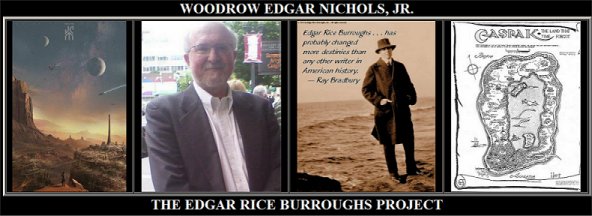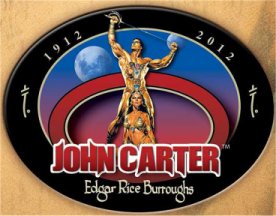The discerning reader can detect many literary influences that
likely inspired the Caspakian Trilogy, the obvious two being The
Lost World, by Sir Arthur Conan Doyle and Mysterious Island,
by Jules Verne. But I believe there were many more that ERB had no idea
were his hidden muses.
I’ve been reading R.E. Prindle’s Accretion of Memory series on
ERB (as I write, today’s date is June 23, 2012) at ERBzine, and had reason
a couple of weeks ago to seriously contemplate his theory. I was watching
an old Italian sci-fi movie from 1965 called Planet of the Vampires (Italian:
Terrore nello Spazio), directed by Mario Bava, adapted from the short story,
“Un nolte de 21 orcs” (English: “One Night in 21 Hours”), by Reneto Pestriniero,
which, according to the opening credits, had been published in Interplanet
3, a sci-fi magazine (which I assume was an Italian publication) – and
suddenly realized how much the plot resembled the 1979 Ridley Scott film,
Alien.
After two interplanetary spaceships, the Argos and the Galliot, emergency
land on a strange planet after responding to a distress signal, an exploratory
group discovers an alien spaceship with enormous dead alien skeletons outside
and inside, signaling a dangerous threat to our astronauts. Sound familiar?
On top of that, the interplanetary spaceships eerily resemble the horseshoe-shaped
spacecraft in Alien, inside of which, you may recall, resided an
enormous dead alien skeleton at what I assume were the pilot controls.
You may also remember that this ship resided on top of the cave where the
monster alien eggs were being cultivated.
I have no idea whether Ridley Scott or the script writer, Dan O’Bannon
– who based his script on an earlier comedic (the movie is hilarious) sci-fi
low-budget film he wrote with John Carpenter, who directed it, called,
Dark
Star – or even H. R. Giger, the Swiss surrealist set designer, had
ever seen this movie before (Wikipedia reports that Scott and O’Bannon
denied that they had ever seen Planet of the Vampires at the time
when Alien was released), but it is likely that they may have seen
it and legitimately did not remember it. Which only goes to show how deep
and unaware memory accretion can be.
By the way, even though the spaceships have obvious Earth names – the
Argos and the Galliot – that invoke Greek mythology and the Enlightenment
(Jason and the Argonauts; Galileo), the human crew who thought that they
were saving their home planet, not only failed to do so, but their home
planet was not even the Earth. After the disembodied aliens have taken
over the bodies of the human captain and the sexy redhead from the Argos,
they approach a planet out of necessity which turns out to be our Earth
in the year 1965. Hehehehe, there’s really nothing quite like the Italian
cinema.
I am also reminded of George Harrison writing “My Sweet Lord,”
totally unaware that he was rewriting the first Top 40 AM radio monster
hit of 1963, “He’s So Fine,” by the Chiffons (the first monster
Top 40 hit of all time was “Sherry,” by the Four Seasons in 1962
– one of the developers of the Top 40 format was from KYNO in Fresno),
which was played on the radio at least four times every hour for weeks
and weeks and became an annoying tune that wouldn’t go away in the back
of your mind and then went on to haunt the “born under a bad sign” Baby
Boomer Generation for decades to come:
“(Do-lang, do-lang, do-lang)
(Do-lang, do-lang)
He’s so fine
(Do-lang, do-lang, do-lang)
Wish he were mine
(Do-lang, do-lang, do-lang)
That handsome boy over there
(Do-lang, do-lang, do-lang)
The one with the wavy hair
(Do-lang, do-lang, do-lang)
I don’t know how I’m gonna do it
(Do-lang, do-lang, do-lang)
But I’m gonna make him mine
(Do-lang, do-lang, do-lang)
He’s the envy of all the girls
(Do-lang, do-lang, do-lang)
It’s just a matter of time
(Do-lang, do-lang)”
(The Chiffons; first verse; written by Ronald
Mack [with a song like “He’s So Fine,” you gotta know it was written
by a guy]; produced by Phil Margo, Mitch Margo, Jay Siegal, and Hank Medress;
© December 1962.)
I can remember explicitly the first time I entered the main student body
hall at the University of British Columbia in January of 1971 when I was
an agent for the Vancouver branch of a fundamentalist Christian evangelistic
outreach group from Seattle known as the Jesus People Army. I was in my
fifth month of a ten year period of strong mental delusion beginning when
I was first taught by this group that every word in the Bible was the Word
of God and absolutely true. To disbelieve this basic tenet was disobedience
to God and his Ten Commandments and warranted punishment and mucho bad
karma.
Sure, I always kept open a little window of skepticism – which eventually
saved me – but at the time this kind of belief system gave me immense confidence,
and I was eagerly looking forward to some face-to-face argument and debate
with some of the atheist students. As I entered the hall I heard a familiar
song in the background played on the school audio system, and I thought,
Oh, I know that song, an oldie but a goodie...oh, what is it?...and then
I was distracted...and then I heard the unmistakable voice of George Harrison,
and I thought, wow, I must have been totally mistaken, it’s a brand new
song.
It was that last part in the first verse, “I don’t know how I’m gonna
do it...” – that was the part that sounded so familiar to me – but now
that I really listened it was different; now it was, “I really want to
know him, I really want to go with him....” Hmm, Harrison wrote a “He’s
So Fine” love song to his god.
I for one actually believe that Harrison didn’t know he was ripping
off another man’s song when he wrote “My Sweet Lord.” After all,
to him, it was pure religious inspiration. When he thought of romantic
love for his god this melody came to his mind like a creative rush – like
an epiphany – for it was in the collective memory, like it or not. Thanks
to the Top 40 AM radio format, Ronald Mack had become a religious muse.
As John Lennon is purported to have said, ‘Hey, George, all you had to
do was change a couple of bars and you would have gotten away with it.”
But that’s how it goes with music, and especially with memory.
And then there is the memory of the original work which won great critical
acclaim, later changed by the artist or from the director’s notes. And
in my opinion there is good reason why the originals won such acclaim.
They may not have been exactly as the “auteur” desired, but they were always
better.
Four classic examples of this are Touch of Evil, Star Wars, Apocalypse
Now, and Bladerunner. First, Touch of Evil was best known
for its long opening tracking shot as a car, loaded with a dynamite bomb
on a timer, eventually blows up as it travels through a border town.
The scene was heightened by the Henry Mancini soundtrack, which got
cut in the new director’s cut version. Sure, Orson Wells’ director’s notes
indicated that Charlton Heston and Janet Leigh would walk past several
places of businesses, and as they passed each one, the individual music
from each place – getting louder as they approached and fading as they
passed, to be replaced with the louder music of the next place as they
approached – would substitute for the consistent Mancini soundtrack. But
compared to the consistent, stirring Mancini opening, the director’s notes
version fails miserably in comparison. The Studio knew what they were doing
when they hired Henry Mancini. Orson Wells was not a musical genius. The
trouble is, the famous original version with the Mancini music in the opening
shot is rarely shown today, in preference to the arthouse crowd.
Ahhh, Star Wars. I have no idea why George Lucas felt he needed
to change the scene where Han Solo mercilessly shoots down Greedo in the
Cantina. I loved that scene. But in the modern versions, Solo only now
shoots Greedo in self defense. What a crock! I remember the original, the
one that everyone loved.
Same goes for Apocalypse Now. I remember standing in line when
I lived in San Diego for the opening of Superman when Apocalypse
Now was also playing. I was ambivalent about seeing a Vietnam war movie,
but a guy in line told me I had to see it, especially the very end after
the credits. I took his advice and soon watched the movie. I waited in
anticipation at the end as the patrol boat steered its way down the Mekong
River away from the rebel compound as the credits rolled by. And then there
was film perfection: silence, then the radio cracked alive with static,
and the jets radioed-in for the air strike, and then the sky was orange
with napalm as Brando’s Kurtz’ last request, “Kill them all!” was brutally
fulfilled. What a perfect ending! That’s why millions went to this movie.
To think that the only way you can see that ending today is on 30 year
old video tape. Oh, the horror, the horror!
Finally, we come to Bladerunner. This movie flopped when it opened,
but I was part of the loyal cult following of the original, especially
after Ridley Scott began butchering it. Oh, sure, it was a studio decision,
but I loved the Raymond Chandler film noir detective narration of Harrison
Ford. Whether or not he too was a replicant was at best an ambiguous possibility
at the end when he takes off with the girl. I loved that ending.
Oh, well, enough of what bugs me. It just seems like all of this is
like the scene in 1984 when Winston Smith deletes a person from the historical
record, placing an original photograph of the person into the “memory hole.”
One day a person is a person, the next moment he becomes an “unperson,”
erased from existence by Big Brother. I think that in the end the ones
that truly remember the past are haunted by the current official history
of it. As Bob Seeger aptly put it in is his rock n’ roll classic “Night
Moves”: “I remember, I remember....”
BEST SUPPORTING ACTOR
Come on, think about it! If you had to give an Academy Award to one of
the characters in the first book of the trilogy, The Land that Time
Forgot, for best supporting actor, who would it be? The best leading
roles go, of course, to Bowen and Lys, but who most stands out in support
in a male role? Unfortunately, there are no other female roles. So, for
males we have the tugboat Brits. Bradley comes to the forefront, or, if
you like comedy, perhaps Olson? But what about the villain? Personally,
I would give the award to the Baron, the Captain Nemo of this mysterious
island.
He is a brilliant Prussian officer of noble blood, ruthless to his duty
and especially to those he regards as enemies of the Fatherland. As the
U-boat commander, he decides who his enemies are, sinking every ship just
to make sure no one is faking neutrality. He must have prayed to his Prussian
Christian god every night to have the idiot Bowen for an adversary. What
a blessing!
Sure, ERB portrays him as a basic pulp fiction villain, but I believe
that ERB admired him in many ways. Lest we forget, the Barsoomian Mythos
is all about the Martian martial culture, where the Baron could just as
easily fit into the skin of any Martian fighting man. ERB’s father was
a Major in the Union Army of the Potomoc, and ERB had himself rode in the
famous 7th Cavalry of General Custer fame. Yes, Baron Friedrick von Schoenvorts
keeps his eye on the ball at all times and takes the war very seriously
as any rational man would. He gets the Oscar in my book.
C. Unidentified Narrator:
Well, we have reached our Second Trimester, The People that Time
Forgot. It is unlikely that we can fake not being pregnant at this
stage. As the U-33 symbolizes the sperm being ejaculated into the womb
as it travels through the underground cave river into Caspak, so to is
the hidden revelation of Caspakian evolution growing inside of our bellies,
kicking and screaming.... well, maybe not screaming.
The Caspakian Trilogy can also be viewed as three levels of understanding:
(1) the Naive; (2) the Educated; and (3), the Expert. Bowen’s is, of course,
the Naive perspective. Billings, as we shall see, will fall into the Educated
point of view. And Bradley, in the end, provides the Expert level of understanding.
So, keeping this in mind, let us now approach the Educated Level.
You may recall that we covered most of Chapter 1 of The People
that Time Forgot in Part 1 of this series. To quickly review, our
rich, benevolent Unidentified Narrator (U.N.), the man who discovered the
message in the bottle (who may be another fake ERB), has taken Bowen, Jr.’s,
journal back to his father, Bowen Tyler, Sr., who is returning home and
to his place of business in Santa Monica, California, on his yacht, the
Toreador. As our U.N. waits, he strikes up a friendship with the father’s
assistant secretary, Tom Billings, finding that they have many things in
common.
“Caprona has always been considered a
more or less mythical land, though it is vouched for by an eminent navigator
of the eighteenth century; but Bowen’s narrative made it seem very real,
however, many miles of trackless ocean lay between us and it. Yes, that
narrative had us guessing. We were agreed that it was most improbable;
but neither of us could say that anything which it contained was beyond
the range of possibility. The weird flora and fauna of Caspak were as possible
under the thick, warm atmospheric conditions of the superheated crater
as they were in the Mesozoic era under almost exactly similar conditions,
which were then probably world-wide. The assistant secretary had heard
of Caproni and his discoveries, but admitted that he never had taken much
stock in the one or the other. We were agreed that the one statement most
difficult of explanation was that which reported the entire absence of
human young among the various tribes with which Tyler had had intercourse.
This was the one irreconcilable statement of the manuscript. A world of
adults! It was impossible.
“We speculated upon the probable fate of Bradley
and his party of English sailors. Tyler had found the graves of two of
them; how many more might have perished! And Miss La Rue – could a young
girl long have survived the horrors of Caspak after having been separated
from all of her own kind? The assistant secretary wondered if Nobs still
was with her, and then we both smiled at this tacit acceptance of the truth
of the whole uncanny tale.” (PTF/1.)
The trick ERB is pulling off is getting the readers to suspend their disbelief
because two of the characters have just done it themselves. Moreover, by
the U.N. having a dialog with Billings about the manuscript, we are able
to form our first idea of what kind of man the assistant secretary is,
especially since he will unexpectedly take over the first person narration
at the beginning of Chapter 2. The U.N. also shows a sharp insight into
the personality of Bowen as hesums up the tragedy all caused by Bowen’s
bungling:
“If only they hadn’t let the German prisoners
capture the U-33! Bowen should have had better judgment than to have trusted
them at all. The chances are von Schoenvorts succeeded in getting safely
back to Kiel and is strutting around with an Iron Cross this very minute.
With a large supply of oil from the wells they discovered in Caspak, with
plenty of water and ample provisions, there is no reason why they couldn’t
have negotiated the submerged tunnel beneath the barrier cliffs and made
good their escape.
“‘I don’t like ‘em,’ said the assistant secretary;
‘but sometimes you have to hand it to ‘em.’ “‘Yes,’ I growled, ‘and there’s
nothing I’d enjoy more than handing it to them!’ And then the telephone
rang.” (PTF/1.)
Billings receives news that Tyler, Sr., has died on board the Toreador
while she was still at sea. They spend the next ten days burying the father
and arranging plans for the succor of his son:
“Mr. Tom Billings, the late Mr. Tyler’s
secretary, did it all. He is force, energy, initiative and good judgment
combined and personified. I never have beheld a more dynamic young man.
He handled lawyers, courts and executors as a sculptor handles his modeling
clay. He formed, fashioned and forced them to his will. He had been a classmate
of Bowen Tyler at college, and a fraternity brother, and before that he
had been an impoverished and improvident cowpuncher on one of the great
Tyler ranches. Tyler, Sr., had picked him out of the thousands of employees
and made him; or rather Tyler had given him the opportunity, and then Billings
had made himself. Tyler, Jr., as good a judge of men as his father, had
taken him into his friendship, and between the two of them they had turned
out a man who would have died for a Tyler as quickly as we would have for
his flag. Yet there was none of the sycophant or fawner in Billings; ordinarily
I do not wax ethusiastic about men, but this man Billings comes as close
to my conception of what a regular man should be as any I have ever met.
I venture to say that before Bowen J. Tyler sent him to college he had
never heard the word ethics, and yet I am equally sure that in all his
life he never has transgressed a single tenet of the code of ethics of
an American gentleman.” (PTF/1.)
ERB basically informs us that Billings closely resembles the values and
experience of ERB himself. Thus, the first person narration of Billings
is likely to be more honest and selfaware than was the first person narration
of the fool Bowen.
After the ten days are up they immediately set sail on the Toreador,
with a party of forty, including the master and the crew, with Billings
in charge. Our U.N. obviously has lots of money and spare time because
he too goes along on the voyage.
“All during the trip Billings had steadfastly
evaded questions as to how we were to enter Caspak after we had found Caprona.
Bowen Tyler’s manuscript had made it perfectly evident to all that the
subterranean outlet of the Caspakian river was the only means of ingress
or egress to the crater world beyond the impregnable cliffs. Tyler’s party
had been able to navigate this channel because their craft had been a submarine;
but the Toreador could as easily as flown over the cliffs as sailed under
them. Jimmy Hollis and Colin Short whiled away many an hour inventing schemes
for surmounting the obstacle presented by the barrier cliffs, and making
ridiculous wagers as to which one Tom Billings had in mind; but immediately
we were all assured that we had raised Caprona, Billings called us together.”
(PTF/1.)
Billings is as our U.N. described him and he has prepared three different
plans to get over the cliffs. The first is to build a ladder out of cable,
which would be a long and tedious endeavor.
The second is to have a man climb the cliffs by means of a line shot
over the cliffs by a mortar.
The third is the most practical. There is an unassembled water airplane
in boxes in the hold. Billings proposes they assemble it and he will fly
over the cliffs, then send lines down for the rest.
“We rolled the plane down to the water’s
edge, and Billings mounted the pilot’s seat. There was a moment’s delay
as he assured himself that he had everything necessary. Jimmy Hollis went
over his armament and ammunition to see that nothing had been omitted.
Besides pistol and rifle, there was the machine-gun mounted in front of
him on the plane, and ammunition for all three. Bowen’s account of the
terrors of Caspak had impressed us all with the necessity for proper means
of defense.
“At last all was ready. The motor was started,
and we pushed the plane out into the surf. A moment later, and she was
skimming seaward. Gently she rose from the surface of the water, executed
a wide spiral as she mounted rapidly, circled once far above us and then
disaappeared over the crest of the cliffs. We all stood silent and expectant,
our eyes glued upon the towering summit above us. Hollis, who was now in
command, consulted his wrist-watch at frequent intervals.” (PTF/1.)
We are almost at the and of our U.N.’s first person account. Oh, sure,
there is still first person narration going on for the rest of the story,
but it will be from Billing’s poing of view. The shift in perspective is
very swift and blunt and you have to be paying close attention at the beginning
of Chapter 2 to tell that a different person is now telling the story.
But we are getting ahead of ourselves again:
“‘Gad,’ exclaimed Short, ‘we ought to
be hearing from him pretty soon!’
“Hollis laughed nervously. ‘He’s been gone only
ten minutes,’ he announced.
“‘Seems like an hour,’ snapped Short. ‘What’s
that? Did you hear that? He’s firing! It’s the machine-gun! Oh, Lord; and
here we are as helpless as a lot of old ladies ten thousand miles away!
We can’t do a thing. We don’t know what’s happening. Why didn’t he let
one of us go with him?’
“Yes, it was the machine-gun. We would hear it
distinctly for at least a minute. Then came silence. That was two weeks
ago. We have had no sign nor signal from Tom Billings since.” (PTF/1.)
And that’s the end of Chapter 1. When he begin Chapter 2, we will discover
that Tom Billings is our first person narrator. But for all the praise
heaped upon Billings by the U.N., he has some terrible character flaws,
which we will learn in the chapters to come.





![]()

![]()

